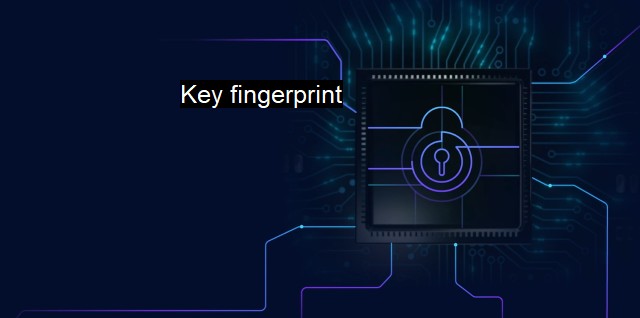What is Key fingerprint?
The Importance of Key Fingerprint in Cybersecurity: A Unique Identifier for Cryptographic Keys
In the context of cybersecurity and antivirus protocols, the term 'key fingerprint' plays an invaluable role, laying the groundwork for secure communication and transaction over networks, particularly the internet. A key fingerprint is a shorter, more manageable form of a public key that's used to uniquely identify a longer public encryption key. Simply put, it's a type of digital identity for a user's or network's encryption key.An encryption key, to clarify, is a complex series of numbers and symbols used in cryptography to encrypt and decrypt sensitive data. This key is generally long and complex to ensure that it's hard to crack. These often excessively-long keys can pose difficulties in terms of handling and verification. This is where the concept of key fingerprint comes into the picture. By effectively shrinking a long and complex public key into a short, user-friendly string of numbers and letters, identifying and authenticating digital keys becomes significantly simple and efficient.
The robustness of a key fingerprint is centered on the idea of hashing. Hashing is a form of cryptographic algorithm that transforms a string of characters into a fixed length value or key that represents the original string. Inputs of different lengths are accepted, and the output is always of a fixed length. Thus, a hash function can take an input (or 'message') and return a fixed-length string of bytes, which essentially is the key fingerprint.
The reliability and uniqueness of a key fingerprint hinge on the hash function’s ability to generate a unique fingerprint for each unique input, even if the differences between input keys are incredibly minute. Therefore, although the chances are infinitesimally slim, creating cryptographic algorithms that rule out hash collisions (occurrences where different inputs generate identical fingerprints) vote significantly in favor of cybersecurity.
In the cybersecurity context, public key fingerprints are frequently used in network protocols, such as Secure Shell (SSH). An SSH key fingerprint is a convenient way to uniquely identify an SSH key, which is otherwise much larger and not as user-friendly. SSH employs public-key cryptography where a pair of keys, one public that everyone can see and one private that only the owner sees, work together. The fingerprint plays a crucial role in figuring out if the public key used by a client matches with one the server trusts, thus ensuring a secure connection.
To illustrate its importance in antivirus applications, consider software signatures. Antivirus software combs through the lines of codes in search of specific software signatures that match known malicious software. These software signatures often use key fingerprints; the compact version of larger strings of data, making the comparison efficient and manageable.
Key fingerprint ensures that digital keys used in software application are indeed from the original source they claim to be, and have not been tampered throughout communication or transfer processes. what makes key fingerprint an indispensable tool in password management, secure communication, antivirus and anti-malware programs, is its role of acting as a quicker and convenient stand-in for lengthy and complicated public keys.
The cyber-world is fraught with threats and vulnerabilities seeking to compromise private information, making secure communication much more than a mere option, it is paramount. Key fingerprint, hinged onto cryptography and hash functions, does its part in increasing cybersecurity by transforming very lengthy keys into easily verifiable, secure identifiers. It plays a pivotal role in ensuring accuracy, reliability and in providing secure communication over the uncertain world of the internet.

Key fingerprint FAQs
What is a key fingerprint in cybersecurity?
A key fingerprint is a unique identifier for a cryptographic key in cybersecurity. It is a fixed-length sequence of characters that represents the key and can be used for verification purposes to ensure the authenticity and integrity of the key.How is a key fingerprint generated?
A key fingerprint is generated using a hashing algorithm that converts the key data into a fixed-length string of characters. The most common hashing algorithm used for generating key fingerprints is SHA-1, but other algorithms such as SHA-256 and MD5 may also be used.Why is key fingerprint important in antivirus software?
Key fingerprint is important in antivirus software because it helps verify the authenticity and integrity of the software updates or virus signature files. By comparing the key fingerprint of the downloaded file with the one provided by the antivirus vendor, users can ensure that the update or signature file is not tampered with, and that it is from a trusted source.Can key fingerprint be used to detect malware?
While key fingerprint is not a direct method for detecting malware, it can be used as part of a security mechanism, such as digital signatures, to detect malware. When a malware author signs the malicious code with their private key, the key fingerprint can be used to verify the signature and identify the author. This information can be used by antivirus software to detect and block the same malware in other systems.| | A | | | B | | | C | | | D | | | E | | | F | | | G | | | H | | | I | | | J | | | K | | | L | | | M | |
| | N | | | O | | | P | | | Q | | | R | | | S | | | T | | | U | | | V | | | W | | | X | | | Y | | | Z | |
| | 1 | | | 2 | | | 3 | | | 4 | | | 7 | | | 8 | | |||||||